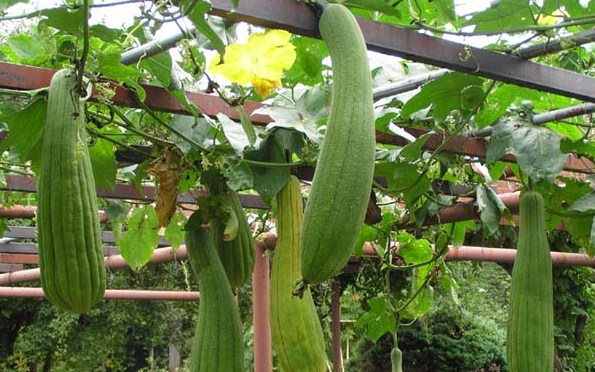Sponge Gourd Cultivation Info:

Introduction of Sponge Gourd:- Sponge gourd is a one of the popular vegetables similar to ridge gourd. The only difference is sponge gourd has smooth surface. Sponge gourd belongs to the family of “Cucurbitaceae” and genus of “Luffa”. This vegetable contains vitamin “A” and “C”. Fully ripe sponge gourds have high volume of fibrous which is being used as cleansing agent (utensils) and making shoe-soles, table mats. This vegetable is cultivated in most of the states in India.
Health Benefits of Sponge Gourd:- Following are some of the health benefits of Sponge Gourd.
- Sponge gourd has laxative properties
- Sponge gourd is a good source of vitamin “A” and “C”
- Sponge gourd is a cure for jaundice
- Sponge gourd is a excellent blood purifier
- Sponge gourd is good for diabetes
- Sponge gourd helps in aiding weight loss
- Sponge gourd boosts the immune system
- Sponge gourd is good for skin.

Local names for Sponge Gourd in India:- Gilki / Chikni Turai (Hindi), Bhol (Assamese), Jhinga (Bengali), Janhi (Oriya), Gisoda (Gujarati), Neti Beerakaya (Telugu). Heeray kayi (Kannada), Peechinga (Malayalam), Pirkanga (Tamil).
High Sponge Gourd Production Sates of India:- U.P., Punjab, Bihar, Jharkhand, Gujarat, Rajasthan, Haryana and Delhi.
Types and Varieties of Sponge Gourd in India:- There are number of local varieties are grown in India. However, “Pusa Chikni” is very popular high yielding and early maturing variety. It bears the vegetables in 40 to 50 days and shape of the vegetable is cylindrical and colour is in dark green.
- Pusa Chikni => This variety is suitable to be grown throughout India.
- Pusa Supriya => This variety is recommended for Punjab, U.P., Bihar, Jharkhand, Rajasthan, Gujarat, Haryana and Delhi regions.
- Pusa Sneha => This variety is recommended for NCR region.
- Azad Taroi -1 => This variety is recommended for Uttar Pradesh region.
- Azad Taroi-2 => This variety is recommended for Punjab, Tarai region of U.P., Uttarakhand, Bihar, and Jharkhand.
Climate Required for Sponge Gourd Cultivation:- Sponge gourd can be grown from tropical to subtropical climatic conditions, they thrive best in warm and humid conditions. Cool weather or low temperatures and frost conditions are not suitable for its growth.
Soil Requirement for Sponge Gourd Cultivation:- Sponge gourd can be grown on wide range of soils. However, it grows best in well-drained loamy soils with the pH value of 6.5 to 7.0 or neutral to slightly alkaline soil.
Land Preparation in Sponge Gourd Cultivation:- Bring the soil to the fine tilth stage and weed free by giving couple of ploughing. Supplementing the soil with well rotten farm yard manure (FMY) will result in good yield and quality. Add an about 20 tonnes of farm yard manure per 1 hectare land.
Propagation in Sponge Gourd Cultivation:- Propagation of sponge gourd is done through seeds.

Sowing, Spacing and Planting in Sponge Gourd Cultivation:- If you are planning for summer season crop, sponge gourd seeds should be sown in pits where as in other seasons, they should be sown in beds. Seed rate of 4kg is well enough to cover the 1 hectare land. Row spacing of 2 meter should be adopted in the sponge gourd cultivation Sowing 2 to 3 seeds in each pit is preferred in sponge gourd cultivation.
Manures and Fertilizers in Sponge Gourd Cultivation:- Add the farm yard manure of 20 tonnes while preparing the land and in-organic fertilizers of N:P:K in the ratio of 25:35:30 kg/ha land. It is recommended to apply 30 kg /ha ‘N’ at flowering stage.
Irrigation in Sponge Gourd Cultivation:- Generally, irrigation should be given based on soil type and weather conditions. In long dry weather conditions, irrigation should be carried twice a week and in rainy season, there is no need of irrigation. However, in extreme hot areas, mulching can be practiced to prevent the water loss or control the weeds.
Inter cultural operations and Weed Control in Sponge Gourd Cultivation:- To control any weeds, the first step should be mulching and then weedicides. Spraying Ethrel of 250 ppm at 4 leaf stage can produce more flowers and the yield. During the rainy season, these plants should be trained by stalking sorghum straw.
Harvesting in Sponge Gourd Cultivation:- Sponge gourd vegetable should be harvested in tender stage without any delay.
Yield in Sponge Gourd Cultivation:- Yield always depends on the cultivation practices and the variety. An average yield of 160 to 200 quintals per hectare can be obtained.
If you are interested in commercial goat or sheep farming information: Read Here.
Can seeds sown in warm water